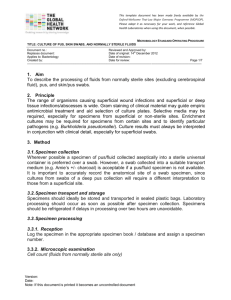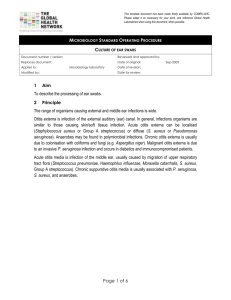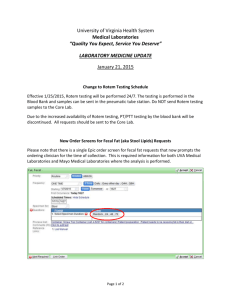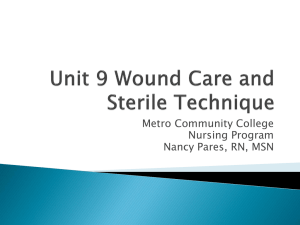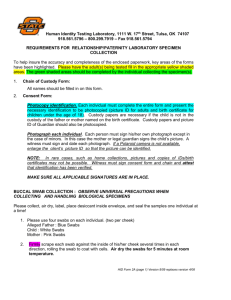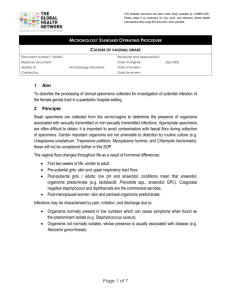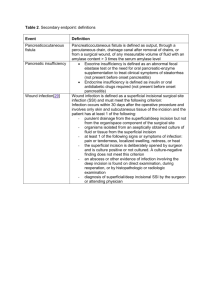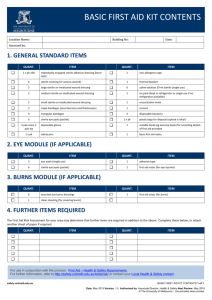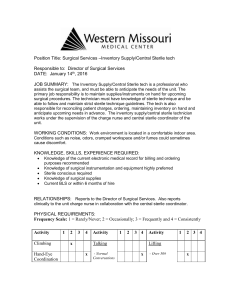Culture of pus, sterile fluids and superficial skin/wound swabs
advertisement
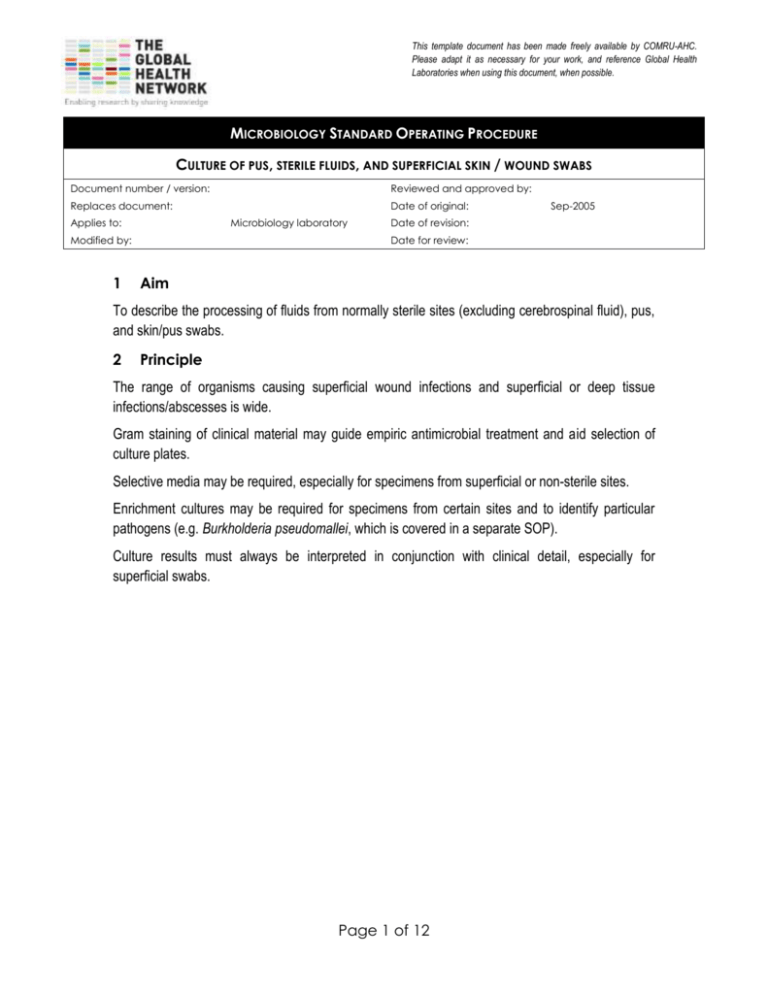
This template document has been made freely available by COMRU-AHC. Please adapt it as necessary for your work, and reference Global Health Laboratories when using this document, when possible. MICROBIOLOGY STANDARD OPERATING PROCEDURE CULTURE OF PUS, STERILE FLUIDS, AND SUPERFICIAL SKIN / WOUND SWABS Document number / version: Reviewed and approved by: Replaces document: Date of original: Applies to: Microbiology laboratory Modified by: 1 Sep-2005 Date of revision: Date for review: Aim To describe the processing of fluids from normally sterile sites (excluding cerebrospinal fluid), pus, and skin/pus swabs. 2 Principle The range of organisms causing superficial wound infections and superficial or deep tissue infections/abscesses is wide. Gram staining of clinical material may guide empiric antimicrobial treatment and aid selection of culture plates. Selective media may be required, especially for specimens from superficial or non-sterile sites. Enrichment cultures may be required for specimens from certain sites and to identify particular pathogens (e.g. Burkholderia pseudomallei, which is covered in a separate SOP). Culture results must always be interpreted in conjunction with clinical detail, especially for superficial swabs. Page 1 of 12 This template document has been made freely available by COMRU-AHC. Please adapt it as necessary for your work, and reference Global Health Laboratories when using this document, when possible. MICROBIOLOGY STANDARD OPERATING PROCEDURE CULTURE OF PUS, STERILE FLUIDS, AND SUPERFICIAL SKIN / WOUND SWABS Document number / version: 3 Method 3.1 Specimen collection Wherever possible a specimen of pus/fluid collected aseptically into a sterile universal container is preferred over a swab. However, a swab collected into a suitable transport medium (e.g. Amies +/charcoal) is acceptable if a pus/fluid specimen is not available. It is important to accurately record the anatomical site of a swab specimen, since cultures from swabs of a deep pus collection will require a different interpretation to those from a superficial site. 3.2 Specimen transport and storage Specimens should ideally be stored and transported in sealed plastic bags. Laboratory processing should occur as soon as possible after specimen collection. Specimens should be refrigerated if delays in processing over two hours are unavoidable. 3.3 Specimen processing 3.3.1 Reception Log the specimen in the appropriate specimen book and assign a specimen number. 3.3.2 Microscopic examination 3.3.2.1 Cell count (all sterile fluid specimens) Using a Kova counting chamber perform a cell count on the specimen before it has been centrifuged (refer to urine SOP MIC-006 for details). 3.3.2.2 Gram stain (all specimens) Prepare a thin smear on a clean labeled microcopy slide for Gram stain. Allow the smear to air dry and heat-fix on the electric hotplate before staining. Consider the need for ZN staining (mandatory if TB is suspected). If a swab is received, prepare the slide after performing culture. For pus/fluid specimens, centrifugation should be carried out prior to Gram staining unless the specimen is frank pus or clotted: Centrifuge the specimen in a sterile universal container or Falcon tube at 3,000 g for 10 minutes; Page 2 of 12 This template document has been made freely available by COMRU-AHC. Please adapt it as necessary for your work, and reference Global Health Laboratories when using this document, when possible. MICROBIOLOGY STANDARD OPERATING PROCEDURE CULTURE OF PUS, STERILE FLUIDS, AND SUPERFICIAL SKIN / WOUND SWABS Document number / version: Discard all but 0.5ml of the supernatant with a sterile pipette; Resuspend the pellet in the remaining 0.5ml fluid and use this for preparation of a smear and inoculation of culture media. 3.3.2.3 Wet prep (selected specimens) A wet preparation may be required if amoebae, fungi, or parasites (e.g. paragonimus) are suspected. Place a drop of specimen onto a clean dry slide, cover with a coverslip, and examine using the x10 objective. 3.3.3 Culture Inoculate and incubate culture media as indicated in Table 1. Page 3 of 12 This template document has been made freely available by COMRU-AHC. Please adapt it as necessary for your work, and reference Global Health Laboratories when using this document, when possible. MICROBIOLOGY STANDARD OPERATING PROCEDURE CULTURE OF PUS, STERILE FLUIDS, AND SUPERFICIAL SKIN / WOUND SWABS Document number / version: Table 1. Culture media, conditions, and target organisms Swabs Clinical / Gram strain Standard media All Blood agar Incubation Temp (°C) Atmosphere Time 35 – 37 5 – 10% CO2 40 - 48h Cultures read Target organism(s) Daily β-haemolytic streptococci Pasteurella spp. (bite wounds) S. aureus Vibrio spp. Chocolate agar 35 – 37 5 – 10% CO2 40 - 48h Daily Haemophilus spp. CNA-blood agar 35 – 37 Air 40 - 48h Daily β-haemolytic streptococci S. aureus MacConkey agar 35 – 37 Air 40 - 48h Daily Enterobacteriaceae Pseudomonads If yeast or fungal elements seen Sabouraud agar 35 – 37 Air 40 - 48h Daily Fungi If ?melioid or ASH 35 – 37 Air 48h (Sub Daily B. pseudomallei Page 4 of 12 This template document has been made freely available by COMRU-AHC. Please adapt it as necessary for your work, and reference Global Health Laboratories when using this document, when possible. MICROBIOLOGY STANDARD OPERATING PROCEDURE CULTURE OF PUS, STERILE FLUIDS, AND SUPERFICIAL SKIN / WOUND SWABS Document number / version: parotitis SB to ASH at 48h) SB Pus / Sterile fluids Clinical / Gram strain Standard media All Blood agar Incubation Temp (°C) Atmosphere Time 35 – 37 5 – 10% CO2 40 - 48h Cultures read Target organism(s) Daily β-haemolytic streptococci Pasteurella spp. (bite wounds) S. aureus Vibrio spp. Chocolate agar 35 – 37 5 – 10% CO2 40 - 48h Daily Haemophilus spp. MacConkey agar 35 – 37 Air 40 - 48h Daily Enterobacteriaceae Pseudomonads Sabouraud agar 35 – 37 Air 40 - 48h Page 5 of 12 Daily Fungi This template document has been made freely available by COMRU-AHC. Please adapt it as necessary for your work, and reference Global Health Laboratories when using this document, when possible. MICROBIOLOGY STANDARD OPERATING PROCEDURE CULTURE OF PUS, STERILE FLUIDS, AND SUPERFICIAL SKIN / WOUND SWABS Document number / version: If “non-sterile” site CNA-blood agar 35 – 37 Air 40 - 48h Daily β-haemolytic streptococci S. aureus If ?melioid or parotitis ASH SB 35 – 37 Air 48h (Sub SB to ASH at 48h) Page 6 of 12 Daily B. pseudomallei This template document has been made freely available by COMRU-AHC. Please adapt it as necessary for your work, and reference Global Health Laboratories when using this document, when possible. MICROBIOLOGY STANDARD OPERATING PROCEDURE CULTURE OF PUS, STERILE FLUIDS, AND SUPERFICIAL SKIN / WOUND SWABS Document number / version: 4 Interpretation Record the semi-quantitative growth of each colony type (i.e. +/- to ++++). 4.1 Minimum level of identification in the laboratory In general significant isolates should be identified as fully as possible: potentially significant organisms are summarised in SOP MID-004. All growth from normally sterile site specimens should be considered as potentially significant unless otherwise instructed by the senior clinical microbiologist. In superficial swabs, the following may be identified to a lower level: Enterobacteriaceae “coliforms” level Pseudomonads “pseudomonads” level (species level in burn swab) S. anginosus group Lancefield group level Yeasts “yeasts” level (species level for Cryptococcus sp.) 4.2 Antimicrobial susceptibility testing All significant isolates should have antimicrobial susceptibilities determined according to SOP MIC001. 4.3 Reporting Cell counts (if done). Gram stain results: WBC and organisms detected. Wet prep results (if done): presence or absence of named organisms (e.g. paragonimus ova not seen). Culture: Swabs: presence of significant isolates (e.g. S. aureus); no significant growth / mixed growth of doubtful significance may be used; absence of growth. Pus: presence of significant isolates or absence of growth. Occasionally other results may be appropriate, as directed by the senior clinical microbiologist (e.g. mixed growth from an appendix swab may be reported as “mixed growth of faecal organisms”). Normally sterile fluids: organism(s) isolated or absence of growth. Page 7 of 12 This template document has been made freely available by COMRU-AHC. Please adapt it as necessary for your work, and reference Global Health Laboratories when using this document, when possible. MICROBIOLOGY STANDARD OPERATING PROCEDURE CULTURE OF PUS, STERILE FLUIDS, AND SUPERFICIAL SKIN / WOUND SWABS Document number / version: 5 Quality assurance Media and identification tests should be quality controlled according to the relevant SOP. 6 Limitations Prior antimicrobial use may result in negative cultures. 7 References 1. Standard Operating Procedures from LOMWRU, SMRU and AHC. 2. Health Protection Agency, UK SOPs: BSOP 11: Investigation of skin, superficial and non-surgical wound swabs (Issue 5.1; July 2012). BSOP 14: Investigation of abscesses and deep-seated wound infections (Issue 5.1; July 2012). BSOP 26: Investigation of fluids from normally sterile sites (Issue 5.1; July 2012). Page 8 of 12 This template document has been made freely available by COMRU-AHC. Please adapt it as necessary for your work, and reference Global Health Laboratories when using this document, when possible. MICROBIOLOGY STANDARD OPERATING PROCEDURE CULTURE OF PUS, STERILE FLUIDS, AND SUPERFICIAL SKIN / WOUND SWABS Document number / version: 8 Synopsis / Bench aids Page 9 of 12 This template document has been made freely available by COMRU-AHC. Please adapt it as necessary for your work, and reference Global Health Laboratories when using this document, when possible. MICROBIOLOGY STANDARD OPERATING PROCEDURE CULTURE OF PUS, STERILE FLUIDS, AND SUPERFICIAL SKIN / WOUND SWABS Document number / version: Page 10 of 12 This template document has been made freely available by COMRU-AHC. Please adapt it as necessary for your work, and reference Global Health Laboratories when using this document, when possible. MICROBIOLOGY STANDARD OPERATING PROCEDURE CULTURE OF PUS, STERILE FLUIDS, AND SUPERFICIAL SKIN / WOUND SWABS Document number / version: Page 11 of 12 This template document has been made freely available by COMRU-AHC. Please adapt it as necessary for your work, and reference Global Health Laboratories when using this document, when possible. MICROBIOLOGY STANDARD OPERATING PROCEDURE CULTURE OF PUS, STERILE FLUIDS, AND SUPERFICIAL SKIN / WOUND SWABS Document number / version: 9 Risk assessment COSHH risk assessment - University of Oxford COSHH Assessment Form Description of procedure Culture of skin or wound swabs / pus / body fluids Substances used Variable, depending on organism cultured (may include Gram stain reagents; 3% hydrogen peroxide (catalase test); N,N,N',N'-tetramethyl-1,4phenylenediamine (oxidase test); sodium deoxycholate (bile solubility test); bioMerieux API reagents) Quantities of chemicals used Frequency of SOP use Small Daily Hazards identified Could a less hazardous substance be 1. Autoclaved liquid used instead? 2. Potentially infectious material in sample No 3. Potentially pathogenic bacteria 4. Chemical exposure form bacterial identification tests What measures have you taken to control risk? 1. Training in good laboratory practices (GLP) 2. Appropriate PPE (lab coat, gloves, eye protection) 3. Use of biosafety cabinet for reading of plates / follow-up of BSL-3 organisms (e.g. B. pseudomallei) Checks on control measures Observation and supervision by senior staff Is health surveillance required? Training requirements: No GLP Emergency procedures: Waste disposal procedures: 1. Report all incidents to Safety Adviser 1. Sharps discarded into appropriate rigid 2. Use eyewash for splashes containers for incineration 3. Clean up spills using 1% Virkon or 2. Infectious waste discarded into autoclave bags chemical spill kit or 1% Virkon solution prior to autoclaving and subsequent incineration 3. Chemical waste disposed of according to manufacturer’s instructions Page 12 of 12
